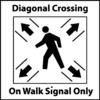 I had the pleasure of visiting Banff, Alberta as a tourist this spring. The downtown area of the city has been remade with pedestrians in mind. The sidewalks are wide, speed limits are reduced and the three pedestrian scrambles move a lot of people more safely than the conventional intersection. Clearly, pedestrians are a welcome part of traffic in the core area.
I had the pleasure of visiting Banff, Alberta as a tourist this spring. The downtown area of the city has been remade with pedestrians in mind. The sidewalks are wide, speed limits are reduced and the three pedestrian scrambles move a lot of people more safely than the conventional intersection. Clearly, pedestrians are a welcome part of traffic in the core area.
By now you are probably wondering what a pedestrian scramble is. Rather than operate the intersection signals as we have come to expect, alternating traffic (including pedestrians) through and across the intersection, Banff’s scramble stops all vehicles for one phase of the traffic lights and allows pedestrians to cross both perpendicularly and diagonally in all directions. In effect, control of the intersection is turned over to pedestrians instead of focusing on moving motor vehicles as a priority.
This system is optimum in urban areas where pedestrian traffic is heavy and sufficient space exists on the sidewalk to accommodate large groups. This is the case in Banff which can see 2,000 pedestrians and 200 vehicles per hour at one downtown intersection in the summer.
Probably the biggest advantage of the pedestrian scramble is the reduction of conflict. During the scramble phase, only pedestrians are moving and all vehicles must stop. Otherwise, only vehicles move and drivers no longer have to worry about pedestrians while making turns. To me, this is a fair exchange. Having to wait a little longer for pedestrians is traded for faster and safer flow on turns.
Implementation of a diagonal crossing can reduce pedestrian casualties by as much as 38% according to Transport for London. I liked it simply because I only had to wait to cross the street once to get to the other side of the intersection when I wasn’t staying on the same side of the street.
There appears to be an alternative system as examples of scrambles that I have found elsewhere allow pedestrians to parallel vehicle traffic for two cycles of the traffic lights. A third cycle of four way red lights to stop all vehicular traffic occurs and allows the scramble to take place.
Some scrambles are also controlled by traffic signals that prohibit right turns during the scramble phase.
Of course, this works well when everyone follows the rules. Pedestrian wait times tend to be longer at a scramble and impatient people could occasionally be seen disobeying the pedestrian controls and dodging vehicles. As it is with drivers, personal convenience can trump traffic laws and consideration for others.
With Vancouver in the news this week for having a higher than normal pedestrian death rate so far in 2016 and the Vancouver Police Department announcing a cyclist and pedestrian safety campaign, one would wonder why cities in B.C. don’t adopt pedestrian scrambles. Well, it appears that Vancouver did consider scrambles in 2011, hoping to implement some on Robson Street similar to one at Moncton and Number 1 Road in Richmond. The city dropped that plan in 2013.
However you choose to cross the street, use a crosswalk, follow the signals, stop, look both ways, hold hands and yield to motor vehicles. Remember that right of way is given, not demanded.
Did you know that there's a Scramble in Steveston?
Seems to work very well, too.
- Log in to post comments
- Log in to post comments

Pedestrian Safety - a vital issue these days!